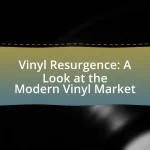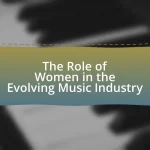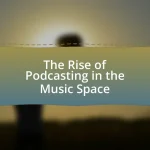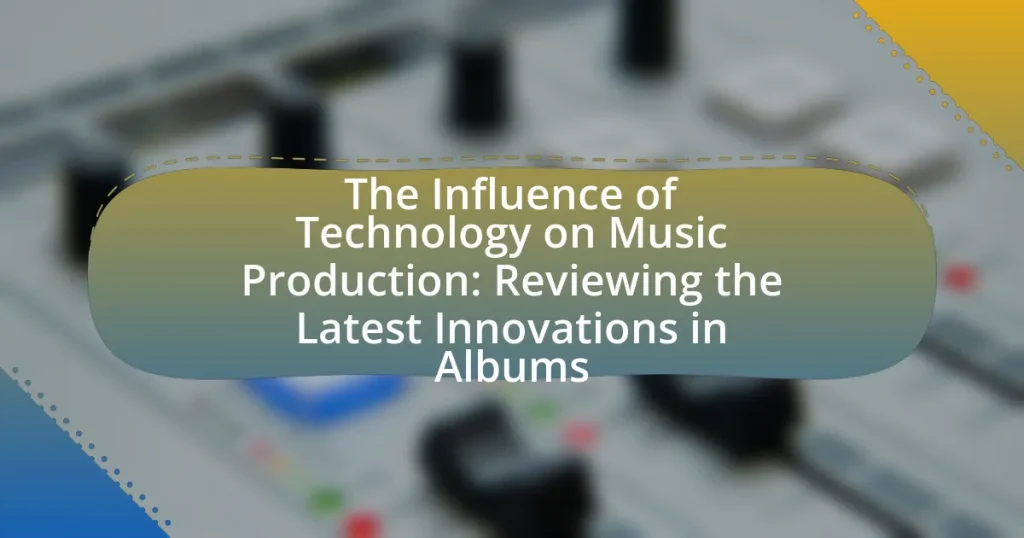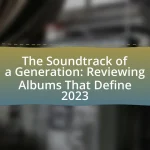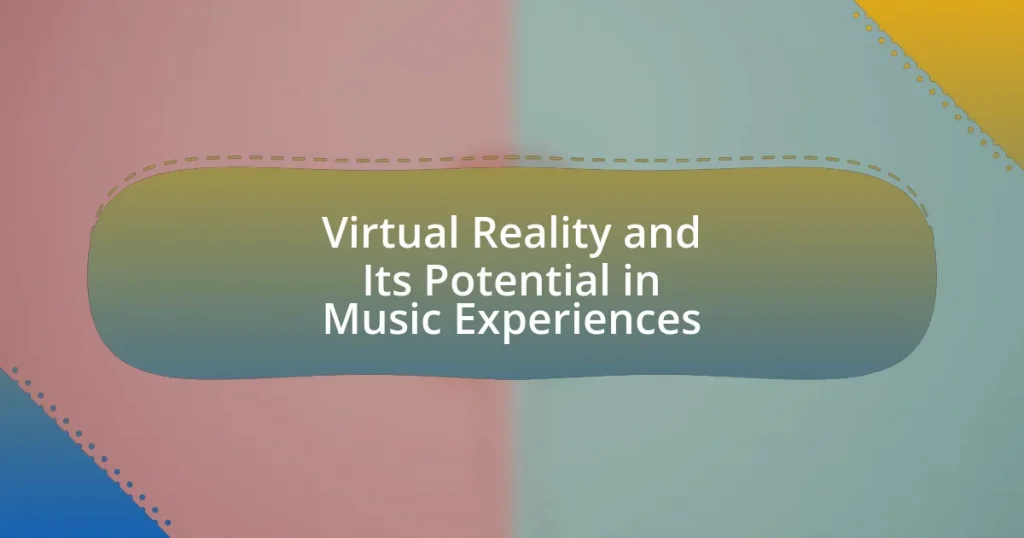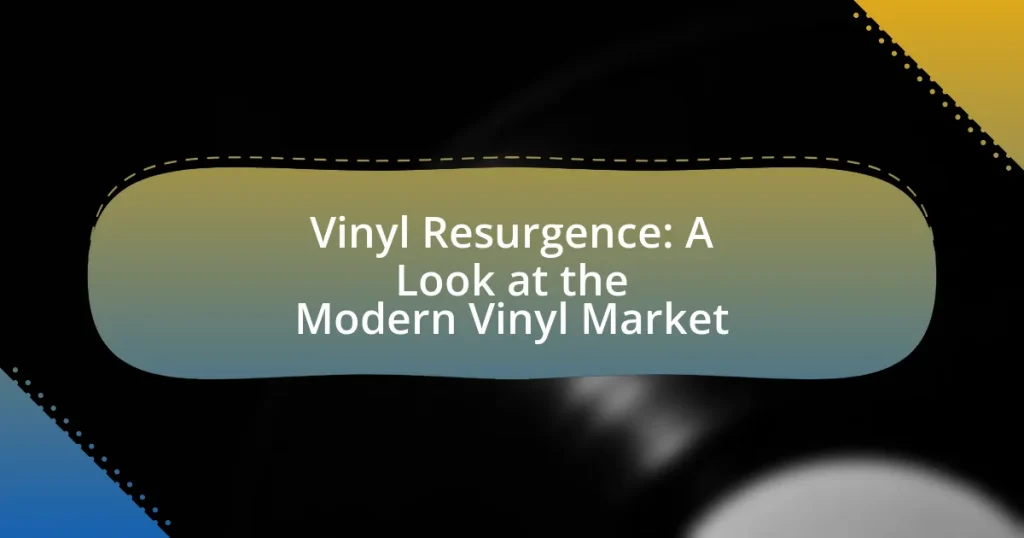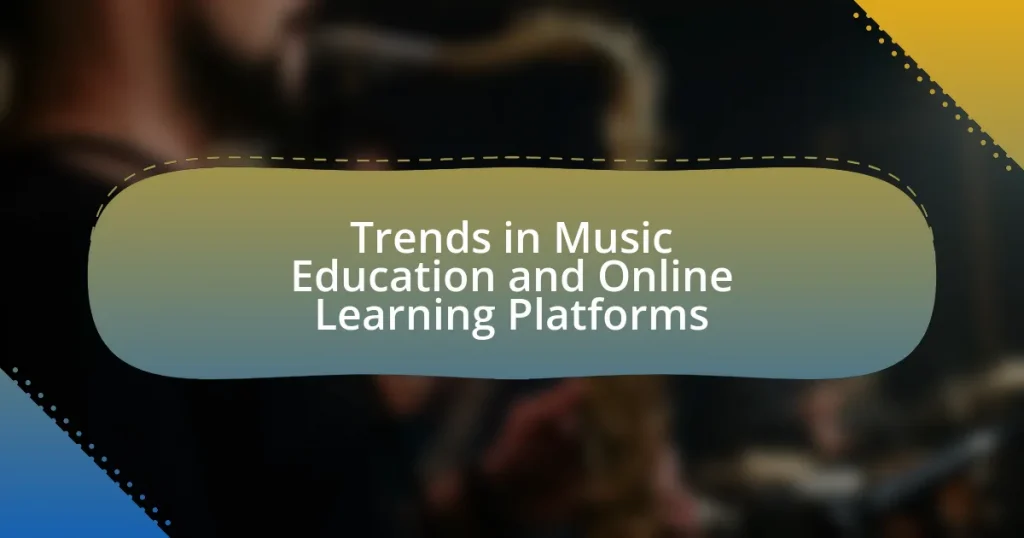The article examines the profound influence of technology on music production, highlighting key innovations such as digital audio workstations (DAWs), virtual instruments, and artificial intelligence. It discusses how these advancements have transformed the music creation process, making it more accessible and efficient for artists, particularly independent musicians. The article also explores the impact of streaming services on album releases, the role of social media in promotion, and the challenges artists face in adapting to new technologies. Additionally, it outlines best practices for effectively utilizing modern production tools to enhance creativity and sound quality in music.
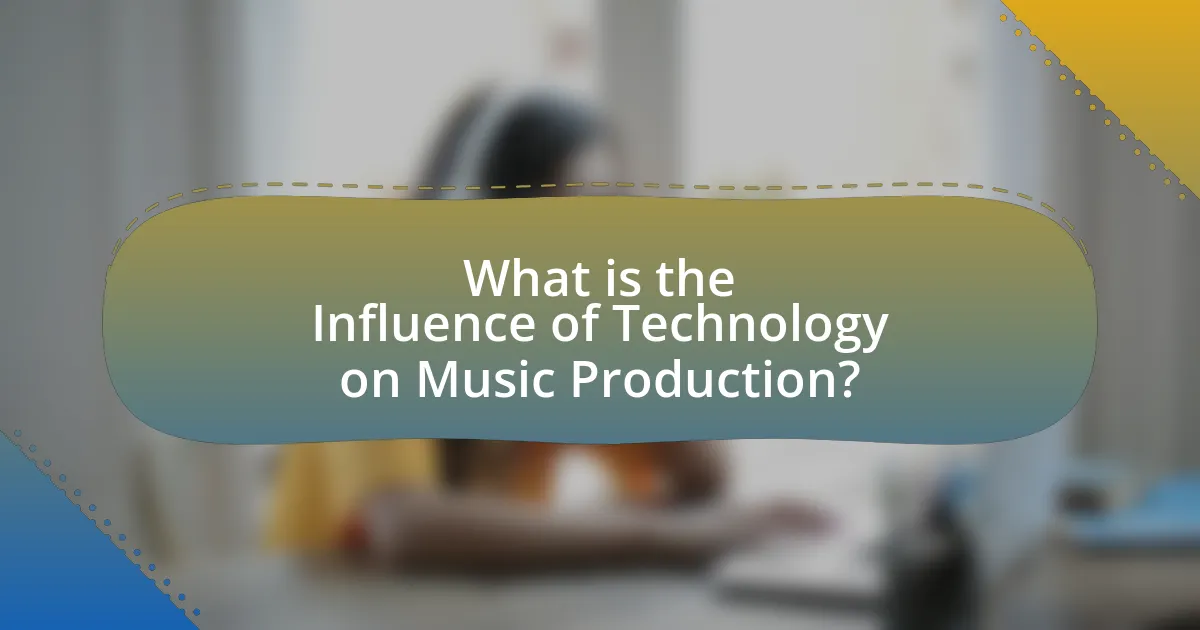
What is the Influence of Technology on Music Production?
The influence of technology on music production is profound, as it has transformed the way music is created, recorded, and distributed. Digital audio workstations (DAWs) like Pro Tools and Ableton Live enable artists to produce high-quality music from their homes, significantly reducing the need for expensive studio time. Additionally, advancements in software plugins and virtual instruments allow for a wider range of sounds and effects, enhancing creativity and production quality. According to a 2021 report by the International Federation of the Phonographic Industry, over 70% of music producers now rely on digital tools, illustrating the shift towards technology-driven production methods. This technological evolution has democratized music production, allowing independent artists to compete with major labels.
How has technology transformed the music production landscape?
Technology has transformed the music production landscape by enabling unprecedented accessibility, efficiency, and creativity in the recording process. Digital audio workstations (DAWs) like Pro Tools and Ableton Live allow producers to record, edit, and mix music with high precision and flexibility, significantly reducing the time and cost associated with traditional studio recording. Additionally, advancements in software plugins and virtual instruments have expanded the sonic palette available to artists, allowing for innovative sound design and experimentation. According to a 2021 report by the International Federation of the Phonographic Industry, over 70% of music producers now utilize digital tools, highlighting the shift from analog to digital production methods. This technological evolution has democratized music creation, enabling independent artists to produce high-quality music without the need for expensive studio time.
What are the key technological advancements in music production?
Key technological advancements in music production include digital audio workstations (DAWs), virtual instruments, and advanced audio plugins. DAWs, such as Ableton Live and Pro Tools, revolutionized music creation by allowing artists to record, edit, and mix music digitally, enhancing workflow efficiency. Virtual instruments, like Native Instruments’ Kontakt, provide realistic sounds and expand creative possibilities without the need for physical instruments. Advanced audio plugins, including those for mastering and sound design, enable precise manipulation of audio, improving overall sound quality. These advancements have transformed the music production landscape, making it more accessible and innovative.
How do these advancements impact the creative process for artists?
Advancements in technology significantly enhance the creative process for artists by providing new tools and platforms for music production. These innovations, such as digital audio workstations (DAWs), virtual instruments, and AI-driven software, enable artists to experiment with sound in ways that were previously impossible. For instance, the integration of AI in music composition allows artists to generate unique melodies and harmonies, expanding their creative possibilities. Additionally, cloud-based collaboration tools facilitate real-time cooperation among artists across the globe, fostering diverse influences and ideas. This technological evolution not only streamlines the production process but also democratizes access to high-quality music creation, empowering a broader range of artists to express their creativity.
Why is understanding technology’s influence on music production important?
Understanding technology’s influence on music production is important because it shapes the creative process, enhances sound quality, and expands accessibility for artists and audiences. Technological advancements, such as digital audio workstations and software plugins, allow producers to manipulate sound in ways that were previously impossible, leading to innovative music styles and production techniques. For instance, the rise of home studio setups has democratized music production, enabling independent artists to create high-quality recordings without the need for expensive studio time. This shift has been supported by data showing that over 50% of music is now produced outside traditional studios, highlighting the significant impact of technology on the industry.
What role does technology play in shaping music genres?
Technology plays a crucial role in shaping music genres by enabling new sounds, production techniques, and distribution methods. Innovations such as digital audio workstations (DAWs), synthesizers, and sampling technology have transformed how music is created, allowing artists to experiment with diverse styles and blend genres. For instance, the rise of electronic music in the late 20th century was largely driven by advancements in synthesizers and computer software, which facilitated the creation of new sounds that defined genres like techno and house. Additionally, streaming platforms have altered how music is consumed, influencing genre popularity and accessibility, as seen with the global rise of K-pop, which leveraged social media and streaming services to reach international audiences.
How does technology affect the accessibility of music production?
Technology significantly enhances the accessibility of music production by providing affordable tools and platforms for creators. Digital audio workstations (DAWs), such as GarageBand and Ableton Live, allow users to produce high-quality music without the need for expensive studio equipment. Additionally, online collaboration tools and cloud storage enable musicians to work together remotely, breaking geographical barriers. According to a 2021 report by the International Federation of the Phonographic Industry, the rise of home studios has led to a 30% increase in independent music releases, demonstrating that technology has democratized music production and made it more inclusive for aspiring artists.
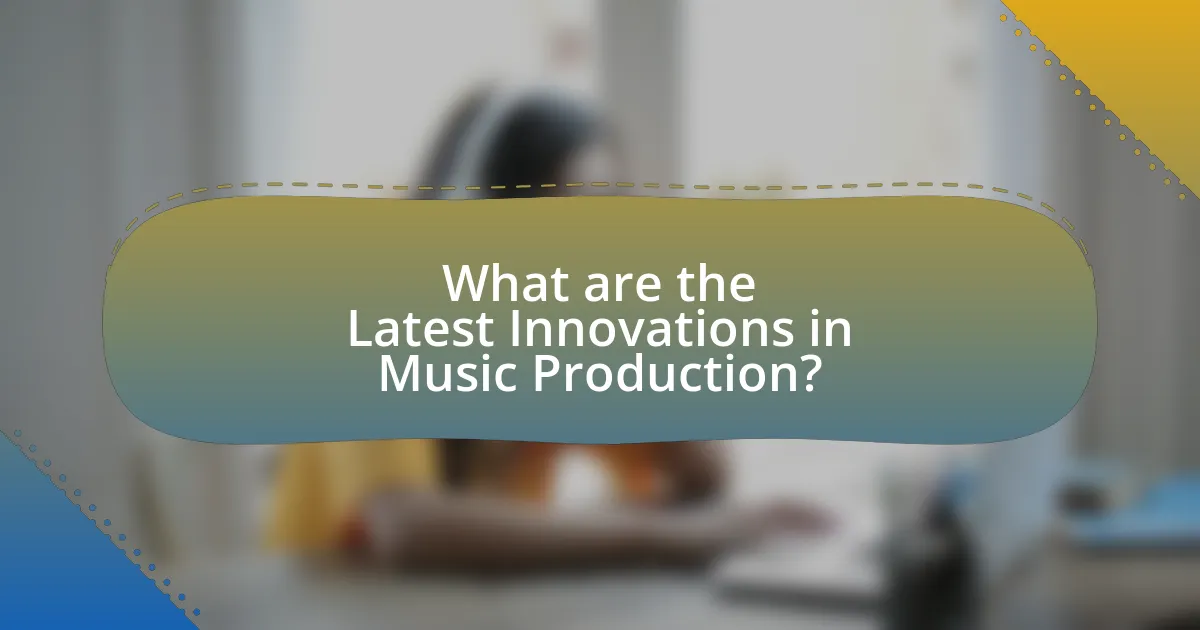
What are the Latest Innovations in Music Production?
The latest innovations in music production include advancements in artificial intelligence, cloud-based collaboration tools, and immersive audio technologies. Artificial intelligence is being utilized for music composition, mixing, and mastering, with tools like AIVA and LANDR automating complex processes and enhancing creativity. Cloud-based platforms such as Splice and Soundtrap enable real-time collaboration among artists and producers, allowing for seamless sharing of projects and resources. Additionally, immersive audio technologies, including Dolby Atmos and spatial audio, are transforming how music is experienced, providing listeners with a more engaging and three-dimensional sound environment. These innovations are reshaping the music production landscape, making it more accessible and dynamic.
What new tools and software are revolutionizing album creation?
New tools and software revolutionizing album creation include platforms like Splice, LANDR, and Avid Pro Tools. Splice offers a cloud-based library of samples and collaboration features that streamline the creative process, allowing artists to access a vast array of sounds and collaborate in real-time. LANDR provides automated mastering services that enhance audio quality without requiring extensive technical knowledge, making professional sound accessible to independent artists. Avid Pro Tools remains a leading digital audio workstation, continuously updating its features to support advanced recording, editing, and mixing capabilities, which are essential for modern album production. These innovations collectively empower musicians to create high-quality albums more efficiently and creatively.
How do digital audio workstations (DAWs) enhance music production?
Digital audio workstations (DAWs) enhance music production by providing a comprehensive platform for recording, editing, mixing, and mastering audio. DAWs streamline the music creation process through features such as multi-track recording, MIDI sequencing, and a wide array of virtual instruments and effects. For instance, the ability to manipulate audio with precision allows producers to achieve high-quality sound that meets industry standards. Additionally, DAWs facilitate collaboration among artists by enabling remote access and sharing of projects, which has become increasingly important in modern music production. The integration of advanced tools within DAWs, such as automation and real-time audio processing, further enhances creative possibilities, making them essential in contemporary music production workflows.
What are the benefits of using virtual instruments in album production?
The benefits of using virtual instruments in album production include enhanced creativity, cost-effectiveness, and accessibility. Virtual instruments allow producers to experiment with a wide range of sounds and styles without the need for physical instruments, which can be expensive and space-consuming. Additionally, they often come with high-quality samples and effects that can elevate the overall sound of an album. According to a 2021 survey by the Music Producers Guild, 78% of producers reported that virtual instruments significantly improved their workflow and creative output, demonstrating their value in modern music production.
How are emerging technologies influencing sound design?
Emerging technologies are significantly influencing sound design by enabling new methods of audio manipulation and creation. Innovations such as artificial intelligence, machine learning, and advanced digital audio workstations allow sound designers to explore complex soundscapes, automate processes, and generate unique audio elements. For instance, AI-driven tools can analyze vast amounts of audio data to create sounds that mimic human creativity, as seen in software like AIVA, which composes music autonomously. Additionally, virtual reality and spatial audio technologies are reshaping how sound is experienced, allowing for immersive environments that enhance storytelling in music and film. These advancements not only expand the creative possibilities for sound designers but also streamline workflows, making high-quality sound production more accessible.
What is the impact of artificial intelligence on music composition?
Artificial intelligence significantly enhances music composition by automating creative processes and generating novel musical ideas. AI algorithms can analyze vast datasets of existing music to identify patterns, styles, and structures, enabling composers to create original pieces that blend various genres and techniques. For instance, tools like OpenAI’s MuseNet and Google’s Magenta utilize deep learning to compose music that mimics the styles of renowned composers, demonstrating AI’s capability to produce high-quality compositions. Additionally, AI can assist in real-time collaboration, allowing musicians to experiment with different arrangements and harmonies, thereby expanding the creative possibilities in music production.
How do immersive technologies like VR and AR change the listening experience?
Immersive technologies like virtual reality (VR) and augmented reality (AR) significantly enhance the listening experience by creating interactive and engaging environments that transform how users perceive sound. These technologies allow listeners to experience music in three-dimensional spaces, where sound can be spatially positioned, leading to a more profound emotional connection and a sense of presence. For instance, a study by the University of California, Berkeley, found that spatial audio in VR environments can increase listener engagement by up to 30%, as users feel enveloped by the music rather than just hearing it from speakers. This immersive quality enables artists to craft unique auditory experiences that can include visual elements, enhancing storytelling and emotional impact in music.
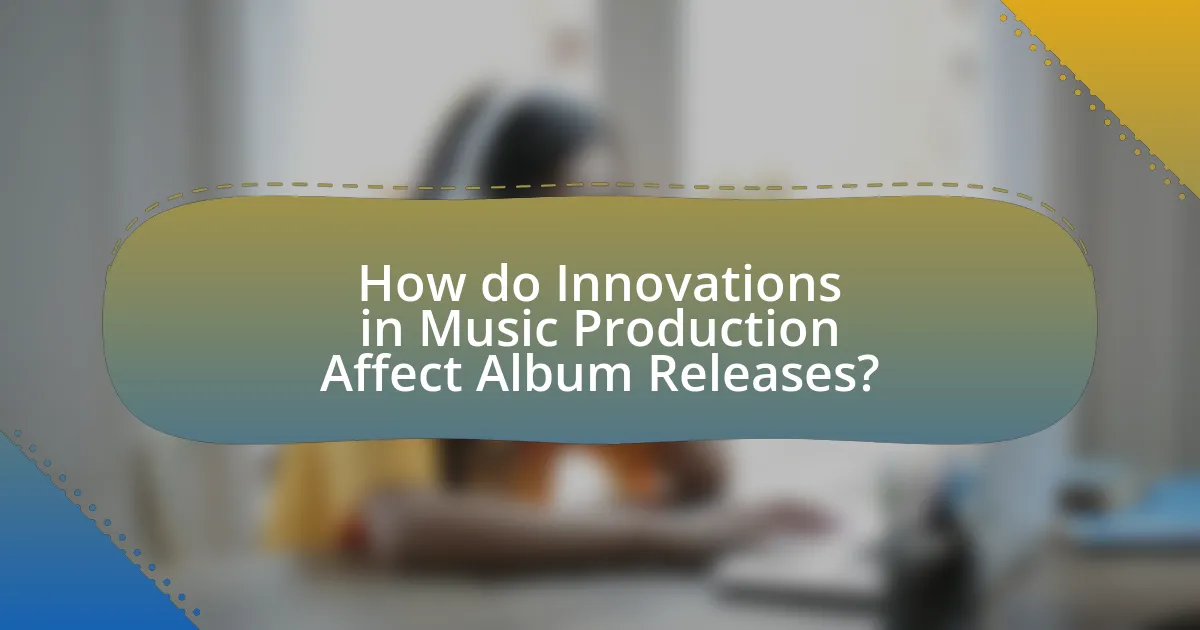
How do Innovations in Music Production Affect Album Releases?
Innovations in music production significantly streamline and enhance the album release process. Advanced technologies such as digital audio workstations (DAWs), artificial intelligence, and cloud-based collaboration tools allow artists to produce high-quality music more efficiently and creatively. For instance, DAWs enable musicians to record, edit, and mix tracks with unprecedented precision, reducing the time and cost associated with traditional studio recording. Additionally, AI tools can assist in generating melodies or harmonies, further accelerating the creative process. The rise of online distribution platforms has also transformed how albums are released, allowing artists to reach global audiences instantly without the need for physical copies. This shift has led to a more dynamic music landscape where artists can release singles or albums more frequently, adapting quickly to market trends and audience feedback.
What changes have occurred in the album release process due to technology?
The album release process has transformed significantly due to technology, primarily through digital distribution, social media promotion, and data analytics. Digital distribution platforms like Spotify and Apple Music have replaced traditional physical sales, allowing artists to release music globally within minutes. Social media enables direct engagement with fans, facilitating real-time feedback and marketing strategies that were previously unavailable. Additionally, data analytics tools provide insights into listener preferences and behaviors, allowing artists and labels to tailor their releases and promotional efforts effectively. These technological advancements have streamlined the release process, making it more accessible and responsive to market demands.
How has streaming changed the way albums are produced and marketed?
Streaming has fundamentally transformed album production and marketing by prioritizing single releases over full albums. This shift is evidenced by the rise of platforms like Spotify and Apple Music, which encourage artists to release individual tracks frequently to maintain listener engagement and visibility on playlists. Consequently, producers now focus on creating standout singles that can capture attention quickly, often leading to shorter album formats and a greater emphasis on immediate listener appeal. Additionally, marketing strategies have evolved to leverage social media and digital analytics, allowing artists to target specific demographics and track listener behavior in real-time, thereby optimizing promotional efforts. This data-driven approach has become essential for successful album launches in the streaming era.
What role does social media play in promoting new albums?
Social media plays a crucial role in promoting new albums by providing artists with a platform to engage directly with their audience, share updates, and create buzz around their releases. This direct interaction allows musicians to build a loyal fan base and generate excitement prior to an album launch. For instance, a study by the University of Southern California found that 70% of music consumers discover new music through social media platforms, highlighting their effectiveness in reaching potential listeners. Additionally, social media enables targeted advertising, allowing artists to reach specific demographics, which can significantly increase album sales and streaming numbers.
What challenges do artists face with new music production technologies?
Artists face several challenges with new music production technologies, including the steep learning curve associated with complex software and hardware. Many artists struggle to adapt to rapidly evolving tools, which can hinder their creative process and productivity. For instance, a survey by the Music Producers Guild found that 60% of producers reported feeling overwhelmed by the pace of technological change, impacting their ability to keep up with industry standards. Additionally, the accessibility of music production software has led to increased competition, making it difficult for artists to stand out in a saturated market. This competition often forces artists to invest in expensive equipment and software, which can be financially burdensome, especially for independent musicians.
How can artists navigate the complexities of modern production tools?
Artists can navigate the complexities of modern production tools by engaging in continuous education and hands-on practice with the software and hardware available. Familiarity with digital audio workstations (DAWs), plugins, and production techniques is essential, as these tools often come with steep learning curves. For instance, a study by the Berklee College of Music highlights that artists who invest time in tutorials and workshops can significantly enhance their production skills, leading to more polished and innovative music. Additionally, collaboration with experienced producers can provide valuable insights and shortcuts, enabling artists to leverage modern technology effectively.
What are common pitfalls in adopting new technologies for album production?
Common pitfalls in adopting new technologies for album production include inadequate training, over-reliance on technology, and neglecting the artistic vision. Inadequate training can lead to inefficient use of new tools, resulting in subpar sound quality or production delays. Over-reliance on technology may cause producers to prioritize technical capabilities over creativity, diminishing the artistic integrity of the album. Additionally, neglecting the artistic vision can result in a product that feels disjointed or lacks coherence, as producers may become too focused on technological features rather than the overall message or theme of the music. These pitfalls can hinder the successful integration of innovative technologies into the album production process.
What best practices should artists follow when utilizing technology in music production?
Artists should prioritize a structured workflow when utilizing technology in music production. This includes organizing sessions with clear labeling of tracks, using templates for consistency, and maintaining a backup system to prevent data loss. Additionally, artists should stay updated on software and hardware advancements, as tools like digital audio workstations (DAWs) and plugins can significantly enhance sound quality and creativity. Research indicates that artists who regularly update their skills and tools can produce higher-quality music, as seen in the rise of successful independent artists leveraging technology effectively.

